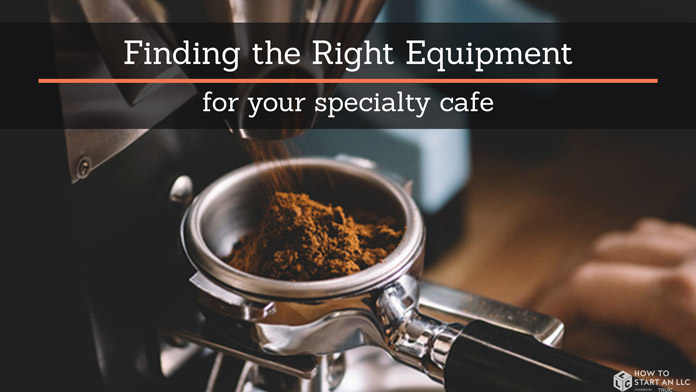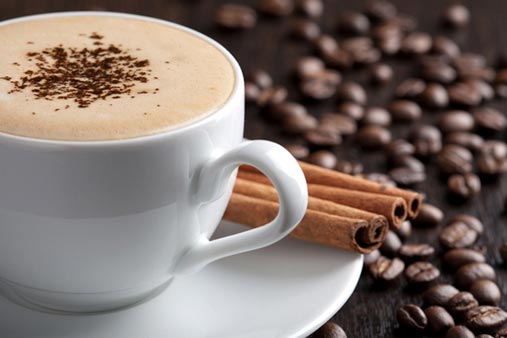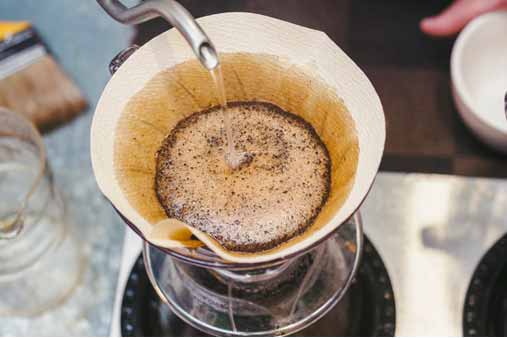Finding the Right Equipment for Your Cafe
When you're opening a coffee shop, selecting the right equipment for your business is a major investment. However, it doesn’t need to be an intimidating process. With research and careful planning, you can keep your costs relatively low, or at least within your budget, and still have all the right equipment to get your cafe ready for opening day.
This guide, written by coffee professionals, will help you choose equipment you’re comfortable using to produce the best coffee possible while navigating the latest trendy coffee tools.
Recommended: Read our full, in-depth How to Start a Coffee Shop Business guides, inspired by coffee professionals, they will help make your coffee dreams real, from sourcing beans to hiring baristas, choosing the best POS system, forming an actual company, and everything in between.

Renting vs. Buying
Let’s start with your decision to rent or buy your coffee equipment. Here are several factors to consider as you evaluate which option is best for you.
Renting
- Lower Upfront Costs – As a renter, you pay less upfront because you only pay an initial fee plus a monthly rental payment vs. covering the full cost of expensive equipment like an espresso machine. This can help small business owners with limited starting capital.
- Decreased Liability – Similar to the difference between owning or renting a home, renting equipment lowers your liability significantly. For example, you won’t be liable for damages if you experience some sort of issue with your rented drip coffee machine.
- Covered Machine Maintenance – Most rental companies provide maintenance with their machines. This means you avoid out-of-pocket expenses for unexpected issues as well as routine maintenance, such as updating parts.
- Greater Flexibility – If you decide your current equipment is not the right fit, you can adjust your rental contract to include different machines that better meet your evolving business needs.
Buying
- Limited Warranties – Manufacturers typically include at least a one-year warranty after you purchase their equipment.
- Resale Potential – If you own your equipment, such as an espresso machine, you can usually recoup part of your original investment by selling the used machine for a fraction of its original cost to another coffee shop. This is a common industry practice and also means you may be able to buy a used machine at lower cost from another cafe. Just make sure any used equipment you buy is in good condition.
- Lower Long-Term Costs – If you don’t plan to order core supplies for your shop through your equipment rental company, you can achieve lower long-term costs by buying your own machines. Moreover, if you don’t like the type of coffee and other supplies offered by your equipment rental company, you’ll be better off sourcing products for your shop elsewhere.
- Flexible Payment Plans – Some equipment manufacturers offer flexible payment plans when you buy their machines. This is particularly helpful for small businesses faced with purchasing a large espresso machine, which can easily cost more than $6,000.
- Increased Liability – As the owner of your espresso machine and other equipment, you are responsible for all maintenance costs. To minimize those costs, you should keep up with routine maintenance by cleaning your machine every night, backflushing it during the day, and replacing smaller parts yourself.
Espresso Machines
Once you decide whether to rent or buy, you then need to identify the specific equipment manufacturers and machines you want to use.
As you evaluate which espresso machine is right for your business, here are several popular choices.
La Marzocco
La Marzocco likely is the most popular brand among third-wave or specialty coffee shops—particularly its Strada and GB5 machines.
La Marzocco Strada
The Strada is the company’s newest offering, delivering an elevated experience for baristas. Key features include:
-
PID-controlled heater, which increases the temperature in set increments until it reaches a desired temperature
-
Double boiler, enabling users to pull shots and steam milk at the same time without affecting the desired temperature
- Individual boilers for each group head, allowing each to operate at a different temperature
- Shot timers
- Easy-to-clean stainless steel parts
- Automatic timers for each group head
- Adjustable pressure on the steam wand
- Articulating steam wands with a pivot base, giving baristas greater range of movement when steaming milk
- Pre-heating system that supports a high order volume (e.g., 50 to 100 shots of espresso per hour) by heating water before it enters the coffee boiler
- Choice of a manual or electronic paddle to control pressure and water flow
Price: More than $22,000 for a two-group Strada machine
Ideal For: The Strada is a great option for any cafe that expects a high customer volume and can afford to pay a little extra for speed, consistency, and ease of use.
La Marzocco GB5
The GB5 is a classic example of a La Marzocco espresso machine. Key features include:
- PID-controlled heater, which increases the temperature in set increments until it reaches a desired temperature
- Choice of an automatic, semi-automatic, or mechanical paddle to control pressure and water flow
- Double boiler, enabling users to pull shots and steam milk at the same time without affecting the desired temperature
- Saturated groups attached directly to the boiler to ensure thermal stability
- Articulating steam wands with a pivot base, giving baristas greater range of movement when steaming milk
Price: Less than $15,000 for a two-group GB5 machine
Ideal For: The GB5 is a good option for coffee shops with low to moderate customer volume that seek simplicity and lower equipment costs.
Victoria Arduino/Nuova Simonelli
Another popular brand, Nuova Simonelli, acquired manufacturer Victoria Arduino to create a one-stop-shop for espresso equipment. With a reputation for stability, efficiency, and ergonomic design, machines from this combined company can help high-volume cafes streamline their workflow and enhance service.
Nuova Simonelli Aurelia
The Nuova Simonelli Aurelia is the only espresso machine ergonomically certified by the European Institute of Ergonomics and Psychology. Key features include:
- Heat exchangers that enable users to steam and pull a shot at the same time—at a faster rate than machines without heat exchangers
- Soft infusion system to guarantee consistently soft and creamy espresso shots
- Cool-touch steam wands to prevent user burns and crusting on the milk wand
- LED light on the milk wand, enabling baristas to see the milk while it steams
Price: More than $8,000 for a two-group machine
Ideal For: The Aurelia is a great fit for moderate- to high-volume cafes seeking to boost efficiencies by streamlining the drink-making process.
Victoria Arduino Black Eagle
The Victoria Arduino Black Eagle is a higher-end offering from this manufacturer. Key features include:
- T3 technology, enabling water to pass through the heat exchangers and then into a brew boiler before making its way into the heated group
- PID-controlled heater, which increases the temperature in set increments until it reaches the desired temperature
- Cool-touch steam wands to prevent user burns and crusting on the milk wand
- Programmable group heads with up to four different volumes
- Easy-to-use digital display
- Pull-push steam levers
Price: More than $20,000 for a two-group machine
Ideal For: The Black Eagle is perfect for coffee shops that can spend a little extra to prioritize workflow and efficiency with an automated machine.
Coffee Grinders
Third-wave coffee shops require a multitude of grinders for espresso and drip coffee. At a minimum, you’ll need a grinder for espresso and another for drip coffee. However, you may want to consider two additional espresso grinders: one for decaf espresso and one for a featured single-origin or guest coffee.
A variety of manufacturers can fulfill your grinder needs, but the most common brands used in third-wave coffee shops include Mahlkönig, Mazzer®, and Bunn®. Here’s an overview of popular models from these brands.
Mahlkönig
You can use an EK43 grinder for drip coffee, manual brew methods, and bagged coffee grinding. Key features include:
- 2.2-pound hopper capacity
- Bags that clamp into the bag holder so users don’t need to hold bags during grinding
- Grind adjustment knob to simplify grind level
- Slide plate lock on hoppers, enabling easy exchange of hoppers with different grinding goods
- Easy to clean
Price: $2,700
The K30 grinder is for espresso only. Key features include:
- Collar grind adjustment
- 3.3-pound hopper capacity
- Creates perfectly dosed grounds in portafilters, saving baristas time during rush periods
- Digital display
Price: $1,750
Mazzer
The Mazzer Robur Electronic grinder is for espresso only. Key features include:
- 4-pound hopper capacity
- Cooling system
- Easy adjustments to ensure simple, efficient espresso pulling
- Conical, stable, 71-millimeter stainless steel burr grinders
Price: $2,995
Bunn
Cafes can use Bunn’s bulk commercial grinder for drip coffee, manual brew methods, and bagged coffee grinding. Key features include:
- Three choices of hopper size
- Efficient, fast grinding
- Easily adjusted grind
- Three-year warranty
Price: $849
Drip Coffee Makers
While your espresso machine may be the heart of your shop, its equally important counterpart is your drip coffee maker. Third-wave coffee shops sell large quantities of drip coffee because it’s easy to make, inexpensive, and, if done correctly, consistently tasty. It gives customers an artisanal flavor packaged as a simple cup of coffee without the higher price of an espresso drink.
Here are several popular options to consider.
Curtis
Curtis is by far the most common brewer with many product models. Key features of the Curtis D1000GT Twin Airpot Brewer include:
- Two programmable brewers
- Digital format for easy adjustments
- Prevents brewing until the water reaches the right temperature
- Adjustable brewing modes
- Single-head version available, if desired
Price: $1,225
The Curtis G4 TP15T Twin ThermoPro Brewer is ideal for higher-volume cafes because it can produce larger quantities of coffee at once. Other key features include:
- Prevents brewing until the water reaches the right temperature
- Digital format, allowing different brew methods as well as customizable options
- ThermoPro vacuum-sealed containers to keep coffee hot and fresh after brewing (sold separately)
Price: $2,500
Bunn
Bunn offers several trusted, classic models, including the BrewWISE Dual TF DBC machine. It features:
- Brewing capacity of up to 18.9 gallons per hour and two pots of coffee at once
- Digital display for easy adjustments
- ThermoPro vacuum-sealed containers to keep coffee hot and fresh after brewing (sold separately)
Price: $2,099
Another good option is the Bunn BrewWISE Single TF DBC machine. It’s a single-head version of the BrewWISE Dual TF DBC machine, offering the same features for less money. It’s ideal for lower-volume cafes that don’t need two pots of coffee brewed at the same time.
Price: $1,559
Other Essential Equipment
Beyond your core coffee-making machines, you’ll need several other essential pieces of equipment to support your cafe. These necessities include:
- Water Filters: Water filtration is an extremely important step in producing quality coffee. Unfiltered water or water with a high mineral content can not only alter the taste of your coffee but also damage your machines. To ensure your cafe only uses filtered water, you can either buy bottled water or install a commercial water filter sized to match your specific espresso machine and drip coffee maker. The most common brands of commercial water softening and filtration systems are Pentair Everpure®, Clive Coffee and Soma.
- Scales: Dependable, long-lasting scales will ensure your staff can accurately weigh coffee grounds for drip coffee, manual brew methods, and every shot of espresso. Popular brands include Jennings®, Hario®, and Acaia. For a comparison of common digital scale models, check out this guide from equipment supplier Prima Coffee.
- Kettles: If you decide to feature a manual brew method in your coffee shop, you may need a gooseneck kettle. This shape is critical to achieving an even extraction process because it guarantees control and a steady stream of water. Popular brands include Hario, Kalita®, Bonavita®, and Fellow Stagg.
- Refrigerators: At a minimum, your cafe will need two refrigerators. One should be small and placed near your baristas so they have easy access to everything they need during the drink-making process. The second should be large enough to store your backup milk supplies and any other perishable items that require refrigeration, such as iced tea.
- Pitcher Rinser: The main benefits of using a pitcher rinser vs. a sink include speed and cleanliness. You can purchase pitcher rinsers from any commercial coffee equipment supplier.
- Milk Pitchers for Steaming: Twenty-ounce pitchers are the most common size used in specialty coffee shops. However, some shops also may use smaller pitchers for cappuccinos and smaller drinks. Depending on your customer volume, you may need two or three pitchers of each size.
- Coffee Tampers: These are available in a variety of weights and materials from popular brands like Chris King® and Reg Barber.
Pro Tip: Buy a selection of coffee tampers so your baristas have a chance to test several and then use the one with which they feel most comfortable.
- Knock Box: Whether you place a knock box for used coffee grounds on your countertop or build one directly into your workspace, it’s a key part of the espresso-making process. Note that the placement of this equipment can impact your cafe’s overall service speed and cleanliness.
- Point-of-sale System: Cash registers are a thing of the past. Most coffee shops now use cloud-based POS systems. A POS system can keep track of all your sales and inventory in one place and lets you offer special discounts to loyal customers. Read our guide on the best POS systems for coffee shops to learn more.

